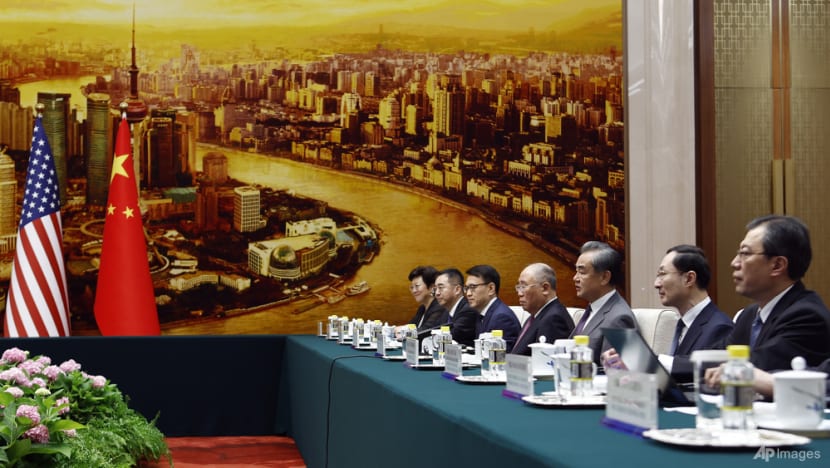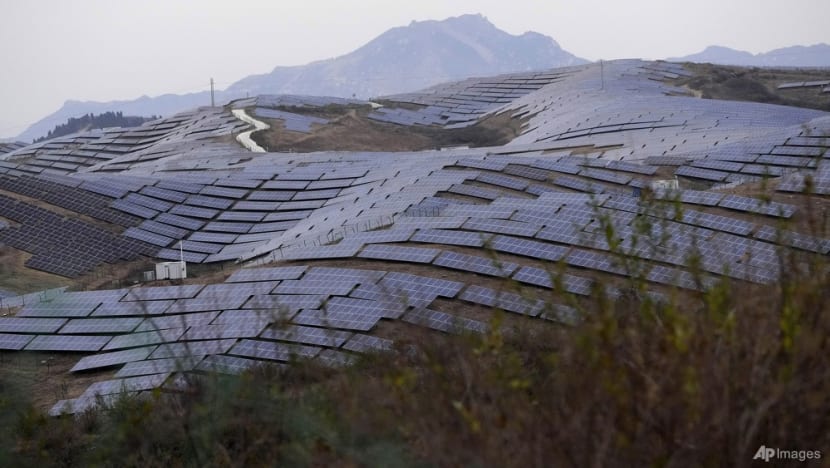COP28: Warming US-China ties to help avoid climate change ‘car crash’ at UN talks
Warming ties between the two global superpowers can help avoid a political “car crash” at upcoming COP28 talks in Dubai, yet analysts remain wary of the chances of genuine policy breakthroughs.


This audio is generated by an AI tool.
BANGKOK: The recent thaw in relations between the United States and China will not be sufficient to address the climate crisis without a serious effort to jointly raise ambition, analysts told CNA ahead of global negotiations in Dubai.
World leaders will converge in the United Arab Emirates for the 28th Conference of the Parties (COP28) beginning tomorrow, with hopes that the agreement earlier this month between the two superpowers could lead to climate breakthroughs.
On Nov 14, the two countries jointly released the Sunnylands Statement on Enhancing Cooperation to Address the Climate Crisis, a comprehensive deal that aligns the pair on many aspects of climate policy.
Released a day before US president Joe Biden and Chinese president Xi Jinping met on the sidelines of the Asia-Pacific Economic Cooperation summit, it includes support to triple global renewable energy capacity by 2030. China also agreed to more ambitious and transparent economy-wide 2035 national climate targets, and both sides will restart various dialogues that have run aground amid political turbulence in recent years.
The two will also aim to work more closely on limiting emissions of methane and nitrous oxide, two greenhouse gases that contribute even more to global warming than carbon dioxide.
The Sunnylands Statement was widely welcomed, but experts cautioned that many issues remain unresolved and will need to be negotiated in depth in Dubai.
NEITHER CONTRIBUTING ENOUGH, CLIMATE ACTION TRACKER SHOWS
The statement was an “important reset moment” that will see the countries re-engage on issues they have historically cooperated on, such as energy policy and carbon capture and sequestration, said Ms Angel Hsu, assistant professor from the Ecology and Energy Programme at the University of North Carolina.
The major question now is how the US and China will take “points of common interest and translate them to higher ambition, which is critically needed”, she said.
At present, neither is contributing its fair share towards needed emission reductions, according to Climate Action Tracker, an independent scientific project that tracks government climate action.
The Sunnylands Statement will help COP28 by setting the “guardrails for political debates in Dubai and will help avoid a car crash there”, said Mr Li Shuo, the incoming director of the China Climate Hub at the Asia Society Policy Institute (ASPI).
“Lines of communication are initiated or re-established, but no breakthrough has been achieved,” he noted.
“Unlike the bilateral climate deals signed during the Obama-Xi period, Sunnylands hardly resolved any of the multilateral issues,” he said. Talks between former US president Barack Obama and Mr Xi from 2013 led to commitments by both sides to cut emissions and the adoption of the Paris climate agreement in 2015.
“In that sense, COP28 still has its work cut out for it,” said Mr Li.
A COP28 HANDSHAKE OR SHOWDOWN?
COP28 is expected to be a difficult edition of the annual summit.
The Israel-Hamas war, on top of the protracted conflict in Ukraine, has ramped up political tensions, put energy markets on edge and raised the possibility that nations will be less willing to make ambitious promises that could weaken their economies short term.
The US and China will both attempt to manoeuvre and eke out progress within this space.
The US push for a total fossil fuel phaseout at COP28 could again rankle Beijing, which continues to permit the expansion of its polluting coal sector.
With the UAE holding the COP presidency, and Sultan Al Jaber, head of the country’s national oil company, at the helm, such a move from Washington is expected to end in failure as it did at COP27 in Egypt last year.
Still, US Special Presidential Envoy for Climate John Kerry told CNA in Singapore earlier this month that he was optimistic about the talks in Dubai.
“We have a very full agenda ahead but I am convinced we have the ability to meet those challenges if we just get a little more serious.”
“No politician can stop what is happening now,” he said. “People are moving because the science is telling us we need to move. It’s not political or ideological, it’s about the air that people breathe.
Mr Kerry and US negotiators, for years reluctant endorsers of a loss and damage fund, will at COP28 continue to propose folding the fund under the remit of the World Bank, a powerful financial organisation that Washington holds much sway over.
Loss and damage is the notion that nations responsible for climate change should provide financial assistance to those suffering the worst impacts. The US has consistently and fiercely railed at paying any form of climate reparations.
CHINA WALKING A FINE LINE BETWEEN TWO WORLDS
Experts expect China to continue walking a fine line between the developed and developing world. It remains reluctant to take on a more intermediary role, they said.
It is a position that deflects calls for Beijing to take on a more assertive role in climate leadership, yet maintains its position of economic influence among countries calling for more financial assistance from the West.
“They are unwilling to agree to developed country obligations, such as contributing to a loss and damage fund, because they see this as a slippery slope to broader obligations. So it seems they are often selective and strategic in how they portray climate leadership,” Ms Hsu said.
This “special” role could come under more pressure from nations feeling restless about the lack of progress on loss and damage in particular.
Beijing will again likely speak in solidarity with those calling for the mobilisation of assistance funds, another possible flash point with Washington, which has been a consistent drag on the concept.
“China should leverage its 'in-between' position to align the (Global) South and North. Its unique status could be the source of an identity crisis, but could also be an asset for Beijing to be a trusted friend with both sides,” Mr Li said.
“The world is anxiously waiting for China to redefine itself,” he said.
China has kept up its breathtaking levels of installing solar and wind power infrastructure and remains crucial to the value chain of green technologies like solar cells, thermal heating and electric vehicles.
But its levels of international engagement have not been fully revived post COVID-19.
Overseas development spending that has been ostensibly frozen under the Belt and Road Initiative has yet to resume in any form under the country’s new project, the Global Development Initiative. A key potential plank of China’s green leadership remains unfulfilled.
For two years, no overseas energy sector lending has been recorded from China’s two development finance institutions to foreign governments, according to research by the Boston University Global Development Policy Center.
“Now is the time for China to use its scale and experience to redirect development finance towards greener goals,” Dr Cecilia Springer, a non-resident fellow with the centre’s Global China Initiative, said in a statement.
But China has remained steadfast about not bowing to outside pressures, a position unlikely to yield at the negotiating tables at COP28.
SMALL STEPS AND RECIPROCITY
Two veteran negotiators are seen as central to the success of US and China ring-fencing their climate relationship from other flashpoints. Mr Kerry and his counterpart Xie Zhenhua met for five days to thrash out the Sunnylands Statement and lay the groundwork for a productive COP.
Their relationship has been a pathway to bilateral synergy since their 2014 joint statement gave momentum to establish the Paris Agreement in 2015.
“I do believe the personal efforts of John Kerry and Xie Zhenhua are notable. Sunnylands is the proof of the power of committed individuals. But clearly, to transcend the significant constraints imposed by contentious bilateral politics, we will need more than individual leadership,” Mr Li said.
The analysts agreed that operating in a politically delicate space was not conducive to bring about the sweeping changes that climate science demands. Nor will Mr Kerry and Mr Xie, who are in their 70s, be able to hold the reins forever. Mr Xie is set to retire in December, Reuters reported this month.
Self interest, economic competition and domestic political considerations are all barriers in the relationship. Both nations also have ambitions for clean energy dominance, Ms Hsu said, “which doesn’t necessarily imply climate cooperation”.
The US has tried to dent China’s grip on supply chains for critical materials for renewable energy production, especially solar panels. President Biden placed a ban on some Chinese polysilicon over concern about the use of Uyghur forced labour in China’s Xinjiang region.
Amid a separate tussle over microchip technology, Beijing this year threatened to ban the export of more of its solar technology, which would stymie the US’ own efforts to domestically produce its own photovoltaic panels.
Such a move could set back the green transition.
“Just because it’s an area ... they find less political contentious doesn’t necessarily imply they share ambition,” Ms Hsu said.
“No side wants to concede more than they receive,” said Ms Sharon Seah, a senior fellow and coordinator of the Climate Change in Southeast Asia Programme at ISEAS-Yusof Ishak Institute.
“So going forward, I think that’s how the relationship will be managed – small steps and always with the principle of reciprocity in mind.”


















